CCNA – Operations 2
Here you will find answers to Operations Questions (part 2)
Question 1
On a network of one department, there are four PCs connected to a switch, as shown in the following figure:
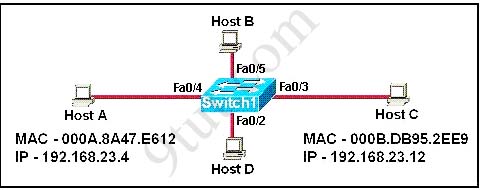
After the Switch1 restarts. Host A ( the host on the left ) sends the first frame to Host C (the host on the right). What the first thing should the switch do?
A. Switch1 will add 192.168.23.12 to the switching table.
B. Switch1 will add 192.168.23.4 to the switching table.
C. Switch1 will add 000A.8A47.E612 to the switching table.
D. None of the above
Answer: C
Explanation
When Switch1 receives the first frame from Host A, it will write Host A’s MAC address into its MAC address table (including the corresponding port Fa0/4) and flood the frame to all other ports.
Question 2
The user of Host1 wants to ping the DSL modem/router at 192.168.1.254. Based on the Host1 ARP table that is shown in the exhibit, what will Host1 do?
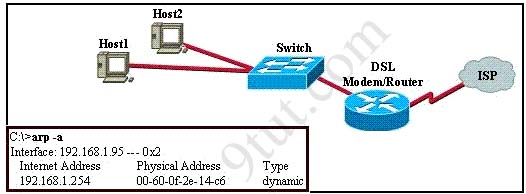
A. send a unicast ARP packet to the DSL modem/router
B. send unicast ICMP packets to the DSL modem/router
C. send Layer 3 broadcast packets to which the DSL modem/router responds
D. send a Layer 2 broadcast that is received by Host2, the switch, and the DSL modem/router
Answer: B
Explanation
Because Host1 has already had information about DSL modem so it doesn’t need to broadcast an ARP Request to find out the MAC address of DSL modem. It just needs to send unicast ICMP packets directly to that modem.
Question 3
Which two values are used by Spanning Tree Protocol to elect a root bridge? (Choose two)
A. amount of RAM
B. bridge priority
C. IOS version
D. IP address
E. MAC address
F. speed of the links
Answer: B E
Question 4
Host 1 is trying to communicate with Host 2. The e0 interface on Router C is down. Which of the following are true? (Choose two.)
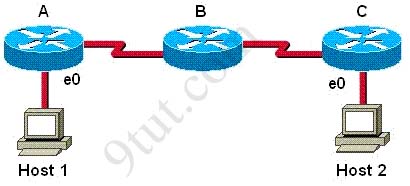
A. Router C will use ICMP to inform Host 1 that Host 2 cannot be reached.
B. Router C will use ICMP to inform Router B that Host 2 cannot be reached.
C. Router C will use ICMP to inform Host 1, Router A, and Router B that Host 2 cannot be reached.
D. Router C will send a Destination Unreachable message type.
E. Router C will send a Router Selection message type.
F. Router C will send a Source Quench message type.
Answer: A D
Explanation
Host 1 is trying to communicate with Host 2. Its packets travel from routerA to routerB and router C. Router C (the last router) then broadcast an ARP frame onto the network looking for the MAC address of Host 2. If Host 2 can answer then router C can forward the frame. But e0 interface is down so no answer from Host 2 will be received so router C will send a Destination Unreachable message back to the originator. This message also informs that the middle network is still working correctly.
Also notice that the Destination Unreachable message is an ICMP message.
Question 5
Refer to the exhibit. The network shown in the exhibit is running the RIPv2 routing protocol. The network has converged, and the routers in this network are functioning properly. The FastEthernet0/0 interface on R1 goes down. In which two ways will the routers in this network respond to this change? (Choose two)

A. All routers will reference their topology database to determine if any backup routes to the 192.168.1.0 network are known.
B. Routers R2 and R3 mark the route as inaccessible and will not accept any further routing updates from R1 until their hold-down timers expire.
C. Because of the split-horizon rule, router R2 will be prevented from sending erroneous information to R1 about connectivity to the 192.168.1.0 network.
D. When router R2 learns from R1 that the link to the 192.168.1.0 network has been lost, R2 will respond by sending a route back to R1 with an infinite metric to the 192.168.1.0 network.
E. R1 will send LSAs to R2 and R3 informing them of this change, and then all routers will send periodic updates at an increased rate until the network again converges.
Answer: C D
Explanation
When Fa0/0 on R1 goes down, R1 will try to inform with R2 that its Fa0/0 interface is currently down. R2 in turn will inform to R3 that Fa0/0 of R1 is down. The split-horizon rule states that “a router never sends information about a route back in same direction which is original information came”. It means when R1 sends information about its downed network 192.168.1.0, R2 is not allowed to send back that information to R1 -> C is correct.
But maybe you will ask “Why answer D is also correct when it seems contradictory to answer C?” Yes, it is really contradictory! This is called the “Poison Reverse” rule:
The poison reverse rule overwrites split horizon rule. For example, if router R2 receives a route poisoning of network 192.168.1.0 from router R1 then router R2 will send an update back to router R1 (which breaks the split horizon rule) with the same poisoned hop count of 16. This ensures all the routers in the domain receive the poisoned route update.
Notice that the “Poison Reverse” doesn’t send erroneous information to R1 but just only one message to make sure R1 is working correctly.
For your information, answer B is not correct because if R2 and R3 get an update with a better metric than the originally recorded metric (1 for R2 and 2 for R3) within the hold-down timer period, the hold-down timer is removed and data can be sent to that network. It means that now R2 and R3 have a better way to reach R1.
For more information about RIP, please read my RIP tutorial.
Question 6
Which of the following describe the process identifier that is used to run OSPF on a router? (Choose two.)
A. It is locally significant.
B. It is globally significant.
C. It is needed to identify a unique instance of an OSPF database.
D. It is an optional parameter required only if multiple OSPF processes are running on the router.
E. All routers in the same OSPF area must have the same process ID if they are to exchange routing information.
Answer: A C
Explanation
The process identifier used in OSPF is locally significant, which means it does not need to be the same on other OSPF routers and is not passed between routers -> A is correct.
Each process identifier is a unique instance of an OSPF database. We can create many process identifiers as we want (but ranges from 1 to 65,535) but it is not recommended because the router needs many resources to maintain these OSPF databases -> C is correct.
Process identifier is a “must” parameter even if we only run only one OSPF process -> D is not correct.
Routers in the same OSPF area can have different process identifier (process ID) because it is only locally significant -> E is not correct.
Question 7
Refer to the exhibit. The FMJ manufacturing company is concerned about unauthorized access to the Payroll Server. The Accounting1, CEO, Mgr1, and Mgr2 workstations should be the only computers with access to the Payroll Server. What two technologies should be implemented to help prevent unauthorized access to the server? (Choose two)
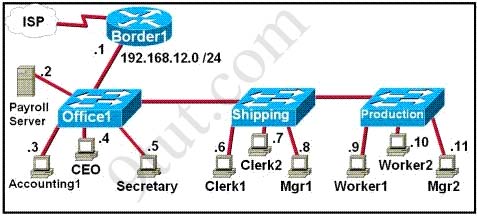
A. access lists
B. encrypted router passwords
C. STP
D. VLANs
E. VTP
F. wireless LANs
Answer: A D
Explanation
Access lists and VLANs can be used to prevent unauthorized to the Payroll Server. By assigning the server to a secure VLAN and using access list to permit only Accounting1, CEO, Mgr1, and Mgr2 workstations to access that VLAN, we can dramatically enhance the security of the whole network.
We don’t need to encrypt router password because it only helps prevent unauthorized access to the router, not Payroll server -> B is not “totally” correct ^^.
Question 8
Which two statements are true about the command ip route 172.16.3.0 255.255.255.0 192.168.2.4? (Choose two.)
A. It establishes a static route to the 172.16.3.0 network.
B. It establishes a static route to the 192.168.2.0 network.
C. It configures the router to send any traffic for an unknown destination to the 172.16.3.0 network.
D. It configures the router to send any traffic for an unknown destination out the interface with the address 192.168.2.4.
E. It uses the default administrative distance.
F. It is a route that would be used last if other routes to the same destination exist.
Answer: A E
Explanation
The command “ip route 172.16.3.0 255.255.255.0 192.168.2.4″ means that “if there is a packet to the network 172.16.3.0/24 then route it to 192.168.2.4 first.
The syntax of static route is:
ip route <subnet-mask> <next-hop-IP-address | exit-interface> [metric]
+ destination-network-address: destination network address of the remote network
+ subnet mask: subnet mask of the destination network
+ next-hop-IP-address: the IP address of the receiving interface on the next-hop router
+ exit-interface: the local interface of this router where the packets will go out
+ metric: the distance metric for this route. If not specified, it uses the default administrative distance of 1
Question 9
Which three statements are correct about RIP version 2? (Choose three)
A. It has the same maximum hop count as version 1.
B. It uses broadcasts for its routing updates.
C. It is a classless routing protocol.
D. It has a lower default administrative distance than RIP version 1.
E. It supports authentication.
F. It does not send the subnet mask in updates.
Answer: A C E
Explanation
A and E are correct according to the theory of RIP.
RIP version 1 updates are broadcasts, and RIP version 2 updates are multicast to 224.0.0.9 -> B is not correct.
RIP v1 is a classful routing protocol but RIP v2 is a classless routing protocol -> C is correct.
RIPv1 and RIPv2 have the same default administrative distance of 120 -> D is not correct.
RIPv2 is a classless routing protocol so it does send the subnet mask in updates -> F is not correct.
Question 10
How should a router that is being used in a Frame Relay network be configured to avoid split horizon issues from preventing routing updates?
A. Configure a separate sub-interface for each PVC with a unique DLCI and subnet assigned to the sub-interface.
B. Configure each Frame Relay circuit as a point-to-point line to support multicast and broadcast traffic.
C. Configure many sub-interfaces on the same subnet.
D. Configure a single sub-interface to establish multiple PVC connections to multiple remote router interfaces.
Answer: A
Explanation
In Frame Relay, one router’s interface is often connected to many other routers. According to the split horizon rule, it is not allowed to send and receive routing updates on the same interfaces so we need to configure sub-interface to overcome this problem.
Question 11
A network administrator is configuring the routers in the graphic for OSPF. The OSPF process has been started and the networks have been configured for Area 0 as shown in the diagram. The network administrator has several options for configuring RouterB to ensure that it will be preferred as the designated router (DR) for the 172.16.1.0 /24 LAN segment. What configuration tasks could be used to establish this preference? (Choose three)
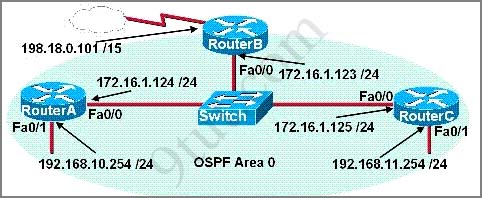
A. Configure the priority value of the Fa0/0 interface of RouterB to a higher value than any other interface on the Ethernet network.
B. Change the router id of Router B by assigning the IP address 172.16.1.130/24 to the Fa0/0 interface of RouterB.
C. Configure a loopback interface on RouterB with an IP address higher than any IP address on the other routers.
D. Change the priority value of the Fa0/0 interface of RouterB to zero.
E. Change the priority values of the Fa0/0 interfaces of RouterA and RouterC to zero.
F. No further configuration is necessary.
Answer: A C E
Explanation
DR and BDR election is done via the Hello protocol. The router with the highest OSPF priority on a segment will become the DR for that segment -> A is correct.
In case of a tie, the router with the highest Router ID will win. The Router ID (RID) is an IP address used to identify the router and is chosen using the following sequence:
+ The highest IP address assigned to a loopback (logical) interface.
+ If a loopback interface is not defined, the highest IP address of all active router’s physical interfaces will be chosen.
+ The router ID can be manually assigned
In this case, the router ID of RouterB is 198.18.0.101 (regardless that interface does not run OSPF). So if we assign the IP address 172.16.1.130/24 to the Fa0/0 interface of RouterB, the router ID of RouterB is not changed and we can not guarantee RouterB will take DR role -> B is not correct.
C is correct as mentioned above.
A priority value of zero indicates an interface will not be elected as DR or BDR. So:
+ If we “change the priority value of the Fa0/0 interface of RouterB to zero”, RouterB will never be elected as DR -> D is not correct.
+ If we “change the priority values of the Fa0/0 interfaces of RouterA and RouterC to zero”, router A and RouterC will not be elected as DR for that segment -> E is correct.
For answer F, if there is no loopback interface configured on RouterA or RouterC then F is correct (as RouterB has the highest IP address on active physical interface 198.18.0.101) but we are not sure about that.



@joy
A. It establishes a static route to the 172.16.3.0 network.
true.
B. It establishes a static route to the 192.168.2.0 network.
false, that’s the network on which the interface of the next hop router is configured
C. It configures the router to send any traffic for an unknown destination to the 172.16.3.0 network.
nope, that’s “ip route 0.0.0.0 0.0.0.0 NEXT HOP/LOCAL INTERFACE”
D. It configures the router to send any traffic for an unknown destination out the interface with the address 192.168.2.4.
false, see above
E. It uses the default administrative distance.
true. the default AD for static routes is 1.
http://www.cisco.com/en/US/tech/tk365/technologies_tech_note09186a0080094195.shtml
F. It is a route that would be used last if other routes to the same destination exist.
we can’t tell that. also, keep in mind that the AD of a static route is 1 while the default AD of any routes via routing protocols is higher than 1. i say “false”
This is what gets me a little frustrated about the people that come up with this exam. For Q1, before I looked at the answer, I chose D. None of the above. Due to the fact that is it not called the “switching table”, but rather the “MAC-address table”, as the explanation for this question clearly states. Now, why must they change the actual name of something, for something else? that does not test your knowledge, it is just frustrating to say the least. BTW, thank you 9tut, I love your site :).
C. Switch1 will add 000A.8A47.E612 to the switching table.
@xallax
which cisco catalyst feature automatically disable the port in an operational PortFast upon of a BPDU
A. backbone fast
B. uplink fast
C. root guard
D. BPDU gaurd
E. BPDU filter
can u answer me
it is D. BPDU gaurd in dump
what is the correct one????
Hi 9tut… Hi Guys! Can you please help me… I will take exam this Feb. Please send me latest dump so that I will have an idea for the exam.. rico.blake@ymail.com
Thanks Guys!
Hi 9tut,
Is this Q11 answers are correct, please check again….
thanks
Please send latest dumps to kstojilkov@yahoo.com
thank
for q4:)
How does the router do ARP broadcast? router will not broadcast is that right!!!!
@all, @xallax, @9tut
Q11.
RID of routerB is 198.18.0.101 but this interface not run OSPF. So although routerB have the interface with IP: 198.18.0.101(this IP add is the highest show in exhibit) but routerB can’t be a DR. In this case DR is RouterC and BDR is routerA.
with Option C: “Configure a loopback interface on RouterB with an IP address higher than any IP address on the other routers” ==> but does not run OSPF on this loopback interface so routerB can’t be a DR.
I think the anwser is: AEF.
Please give me some advances.
thanks!
@kindrock
A is correct. if the priority is the highest then it will always become DR.
B isn’t true. RouterC has an interface with a lower IP value than this
C is true. highest loopback IP address wins.
D. if it is set to 0 then the router will never ever ever become DR. false
E. this would ensure RouterA and RouterC never “run” for becoming DR; RouterB is the only one that participates in the election process and wins. true
F. as 9tut very explained: we can’t be sure that there aren’t any other loopback interfaces configured and that’s why this option is doubtable.
@xallax
thanks so much!
@all, @xallax, @9tut
about Q11.
I still think that answer F is more correct than C because answer C is not completely correct.
C. Configure a loopback interface on RouterB with an IP address higher than any IP address on the other routers.
If higher than any IP address was replaced by higher than any loopback IP address then C was more correct
anyway I love this website.
@mario
it says “higher than ANY IP address on the other routers”.
ANY could mean physical or loopback IP address
since they are class B ip addresses, RIPv1 will only aditsevre them as a /16 for routing advertisments. And only routers directly connected to that specific route will have the VLSM attached in the routing table, labeled with a C.hope it makes sense.
In election of DR, first we look at PRIORITY, if it is same – than we look for LOOPBACK, right? If there are no loopback defined, we look for highest IP on aech router.
My question is, does that IP address have to be ADVERTIZED in OSPF? If Router 1 and Router 2 have same priorities (1), and don’t have any loopback, and R1 have IP 198.18.16.2 and 10.0.0.5 but first one is not advertised in OSPF, what will become Router ID?
Thanks
Roxy:
IF 198.18.16.2 is active (no shutdown for any reason) then it will become the Router ID
The rules as you mention above and the third rule is the highest active physical interface regardless of participating in the OSPF process
I hope that helps
Roxy:you can try it on GNS3 if you have installed it, I recommend it because it is the most closed network emulators to real netowrks
@all, @xallax, @9tut
Q11, Answer C is ONLY correct if the loopback address is configured in Router B’s OSPF network table. Since this is an additional configuration not mentioned in the answer it is an assumption.
Answer F is also an assumption that loopbacks are not configured on routers A and C but is correct given the information given in the diagram.
I answered this question correctly but I just wanted to highlight the hypocrisy of 1 correct and 1 incorrect answer using assumptions.
I PASSED CCNA EXAM TODAY THANKS TO ALL MIGHTY ALLAH
960/1000
I passed my ccna exam today Praise be to God! Thank you Jesus! and thanks to 9TUT for the tutorials and explanations, great site and thanks to xallax for your explanations to questions and thanks to http://www.examcollection.com for the dumps. Pls guys lets donate and help to keep this site up!
48 ques for exams including 3 simulation, I had EIGRP, Acesslist2 and VTP. Make sure the practice the simulation, use packet tracer or gns3. Best wishes to all!
thank you 9tut!
HAI IAM MANIKANDAN I PASSED CCNA EXAM 0N 27 JULY 2012 WITH THE SCORE 870/1000
MY THANKS IS FULLY REGARDS TO http://www.9tut.com ..,THE BEST EVER WEBSITE FOR CCNA EXAM THANKS 9TUT
@xallax @9tut
Question 11
DR/BDR Election
How do the DR and BDR get elected? The following criteria are applied:
1. DR: Router with the highest OSPF interface priority.
2. BDR: Router with the second highest OSPF interface priority.
3. If OSPF interface priorities are equal, the highest router ID is used to break the tie.
Determining the Router ID
The OSPF router ID is used to uniquely identify each router in the OSPF routing domain. A router ID is simply an IP address. Cisco routers derive the router ID based on three criteria and with the following precedence:
1. Use the IP address configured with the OSPF router-id command.
2. If the router-id is not configured, the router chooses highest IP address of any of its loopback interfaces.
3. If no loopback interfaces are configured, the router chooses highest active IP address of any of its physical interfaces.
(Source: CCNA Exploration 2)
** B. Change the router id of Router B by assigning the IP address 172.16.1.130/24 to the Fa0/0 interface of RouterB. **
I’m wondering why B is not considered as one of the answers. If you change the router id of Router B to 172.16.1.130/24, it would be the highest among the 172 network. Can you please enlighten me as to why this answer is not considered? Or maybe you would need to consider the 192 network??? Thanks.
Hi Kai, it’s actually the interface 198.18.0.101 of router B to be considered. As it’s higher than router B’s Fa0/0, it’ll always be the router ID. Answer B will have no effect to it.
@9tut
If i may ask, is context sensitive help in simul lab exam usable or allowed?
Thank You
Cheq
@cheq: Not sure what you ask. The commands are case-insensitive.
@9tut–what i am trying to ask then….is ? or cl? allowed in actual sim lab exam?
Thank You
@cheq: Sometimes you can use Tab and ? but sometimes you can’t. So I recommend you to remember the full commands.
Understanding to the the basis of a problem begins with figuring out the the premise.
question what is the advantage of using multi point than using point subinterfaces in frame relay
@9tut Quiz CCNA – Operations 2 – Q1 -Mising part of the Question
After the Switch1 restarts. Host A ( the host on the left ) sends the first frame to Host C (the host on the right). What the first thing should the switch do?
@Tedy_bear: Yes, thanks for your detection. I updated it!
@maged Multi Point Interface has a disadvantage because routing updates wont travel due to split horizon, which prevents sending routing updates the interface which it received the routing update from. To fix this problem you have to create sub interfaces (ex. R1 s0/0.1 to R2 S0/0 and R1 s0/0.2 to R3 S0/0) , this way you can update both neighbors without split horizon from stopping you ( Take a look at 9tut’s Frame Relay Tut for better understanding )
@xallax,@9tut,@anyone
in q2……as the explanation says…………does this mean that once we know the destination mac addr; we no longer need the ARP ?
plz help me……..m giving my xm in 2 days……tnx
in q4
what is “Router Selection message type” and “Source quench message type” ?
can anyone plz explain………..???…….tnx
Q11
The question states: “The network administrator has several options for configuring RouterB… ”
If we are to take the question literally then A C F would surely be correct!
This is how I initially answered but now is a grey area (excuse the pun). Any thoughts on this?
I luv 9tut, taking ICND1 next month, Could someone Please send me the latest Dumps? dickenst45@yahoo.com
Thanks all and Good Luck to All!!
I HAVE A DOUBT… CAN ANY PASSED ENGINEER PLEASE ANSWER IT ?
IN THE CCNA EXAM, CAN WE SKIP ANY UNKNOWN ANSWER ? OR DO WE HAVE TO ANSWER ALL FROM 1 TO 50 QUESTIONS CONTINUOSLY WITHOUT SKIP ?
THANKS
@ANY ONE ANSWER PLEASE
you can skip but u wont be able to come back to answer that question. its better that u answer all question even u dont the answer.
You cannot skip, or go back!!!!
TY 9tut.
Today I have passed the CCNA. (860/825)
50 questions 3 labs (VTP, EIGRP, ACL). 35 from 9tut.
Also thanks a lot Brar and Sekhar (still valid from examcollection)
Ty again 9tut
from here none
sekar dump pdf file need me pls
Valid Que :D
Q:8
I will take my CCNA 640-802 exams this Feb 25 so every one out there kindly please send me tips and latest dumps, those who has taken theirs at ekasafara@yahoo.com. thank you my good friends as well as 9tut for your help.
ques no 6 was in the exam today
Question 5
Should be B and C
1st answer B is the holddown timer rule when the routers receive an update with same metric they ignore it.
2nd routers either use split horizon or split horizon with poison reverse, can’t use both of them simultaneously.
3rd answer D says “R2 will respond by sending a route back to R1 with an infinite metric to the 192.168.1.0 network”, the network that has gone down is 192.168.2.0 not 192.168.1.0.
oh i’m sorry it’s 192.168.1.0 that has gone down so the 3rd reason is not true
q4 in today exam
Pliz i will sit for the CCNA exam next month, can someone send me the latest dumps on email: olesimbe@yahoo.com
Can any one send me the latest dump email me @kaiser_jude16@hotmail.com
Hi. anyone knows about GNS3? how to download that. Please help sidegrove@yahoo.com